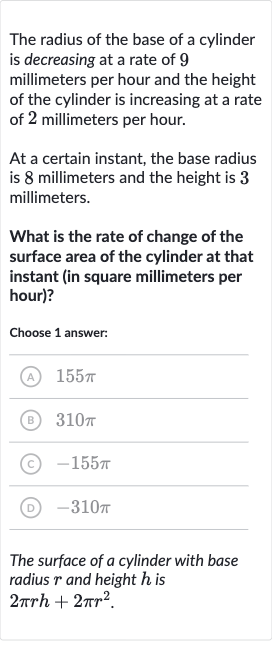AI tutor
Welcome to Bytelearn!
Let’s check out your problem:

The radius of the base of a cylinder is decreasing at a rate of millimeters per hour and the height of the cylinder is increasing at a rate of millimeters per hour.At a certain instant, the base radius is millimeters and the height is millimeters.What is the rate of change of the surface area of the cylinder at that instant (in square millimeters per hour)?Choose answer:(A) (B) (C) (D) The surface of a cylinder with base radius and height is
Full solution
Q. The radius of the base of a cylinder is decreasing at a rate of millimeters per hour and the height of the cylinder is increasing at a rate of millimeters per hour.At a certain instant, the base radius is millimeters and the height is millimeters.What is the rate of change of the surface area of the cylinder at that instant (in square millimeters per hour)?Choose answer:(A) (B) (C) (D) The surface of a cylinder with base radius and height is
- Write Given Information: First, let's write down what we know:The radius is decreasing at mm/hr, so mm/hr.The height is increasing at mm/hr, so mm/hr.At the instant we're considering, mm and mm.The formula for the surface area of a cylinder is .
- Find Rate of Change: Now, we need to find the rate of change of the surface area, . To do this, we'll use the formula for the derivative of the surface area with respect to time: .
- Apply Derivative Formula: Using the product rule and chain rule for differentiation, we get: .
- Substitute Known Values: Plug in the values we know: .
- Perform Calculations: Now, let's do the math:.
- Simplify Expression: Simplify the expression: .
- Combine Terms: Combine the terms: .
- Add Together: Add the two terms together:
More problems from Area of quadrilaterals and triangles: word problems
QuestionGet tutor help
QuestionGet tutor help
QuestionGet tutor help
QuestionGet tutor help
QuestionGet tutor help
QuestionGet tutor help
QuestionGet tutor help
